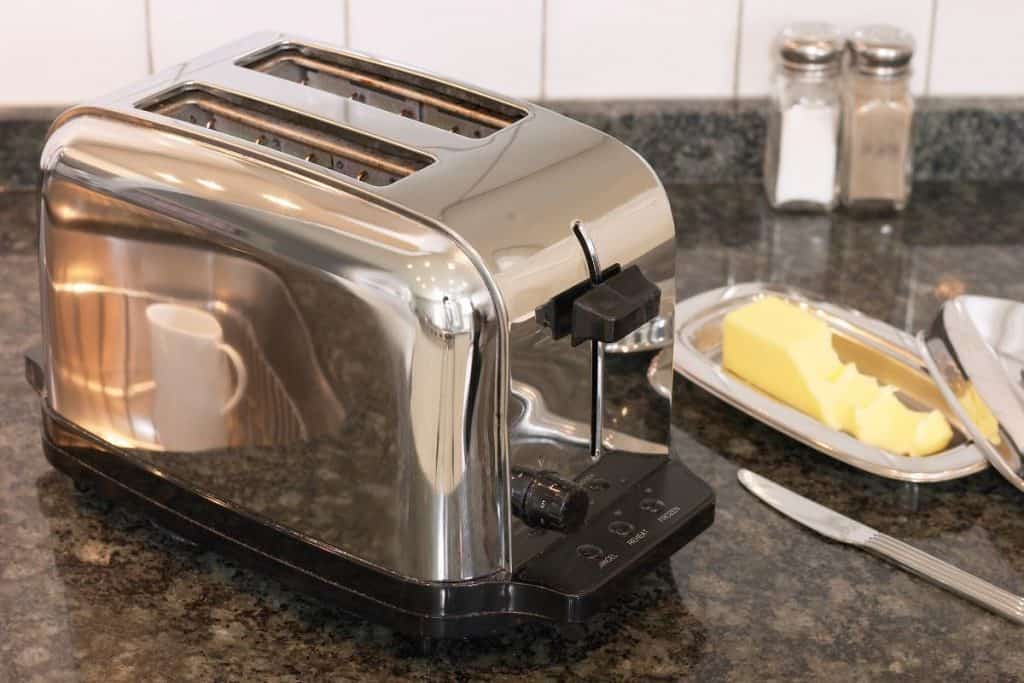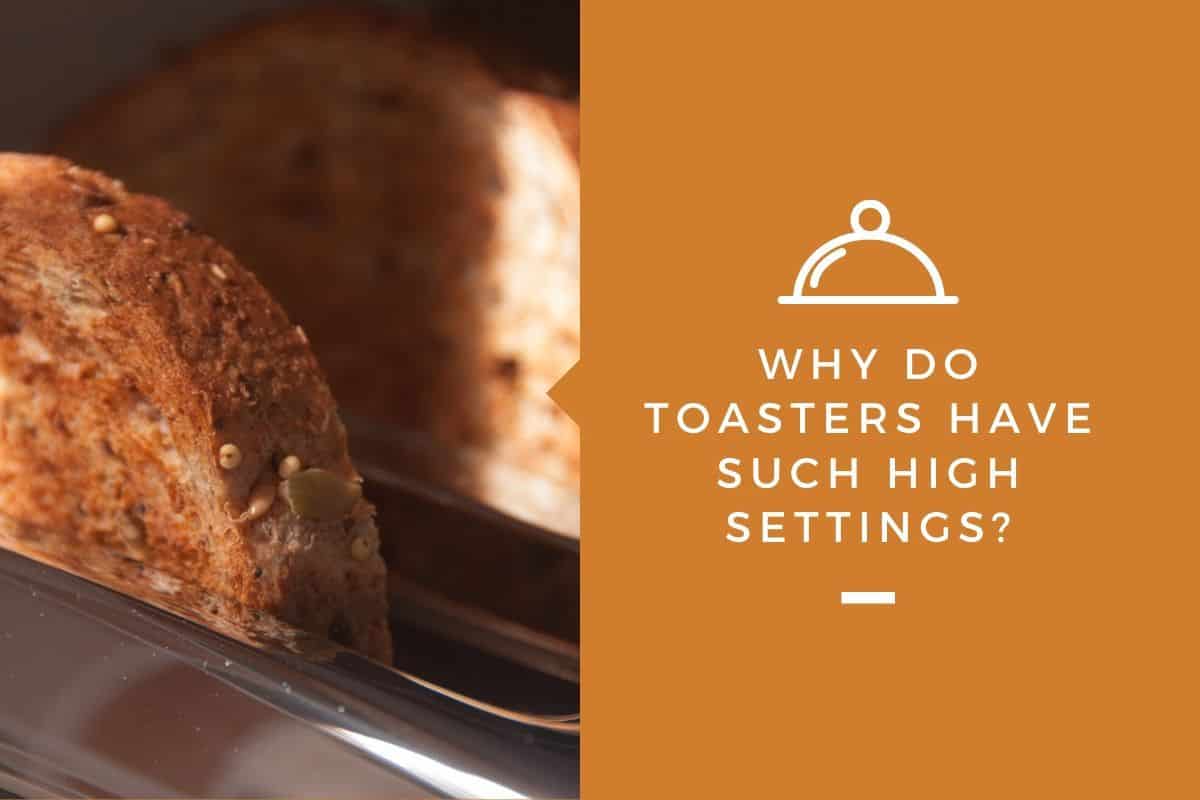Of all the kitchen appliances out there, people question toaster setting more than any of them because the vague setting often requires the user manual to understand, and there is no standardization across toasters. What is true of one toaster, may not be true of another. But all toasters seem to have higher settings than most people consider necessary.
But why do toasters have such high settings? Toasters have high settings because toasters aren’t just used to make toast. Bagels, English muffins, and thicker or denser slices of bread may require extra toasting to reach the desired brownness. Additionally, some people like their toast very dark.
One person’s burnt toast is another person’s breakfast. In this article, we will go over what the toaster setting really mean, when you might when to use a higher toaster setting, and the mysterious bagel setting.
Toaster Settings Explained
Your typical $10 toaster that you might purchase when you get your first apartment will probably have about six settings with no indication of what these numbers actually mean. It may have a cancel setting or a cancel button to stop toasting as well that allows you to stop your bread from over toasting.
Myths abound around the mystery behind these numbers, saying that they are timers or temperature indicators or simply meaningless. Most of us don’t really think about it. As users, we do some experimenting, find the number we like, and stick with it.
But what do they really mean? It depends on your toaster. Toaster settings vary widely from toaster to toaster, even toasters of the same brand. Let’s go over some of the possibilities for what those numbers mean.
Toaster Numbers May Indicate the Passing of Time
In some toasters, and most certainly in toaster ovens, the numbers indicated on the dial represent an increment of time, usually a minute.
These toasters use timers to control the heating elements in the toaster. Once you know how long your toast needs to be in the toaster, you’re all set.
Toaster Numbers May Indicate the Brownness of the Toast
Brownness is what most toasters mean by the numbers on their dial. If the number on the dial indicated a certain level of brownness, the lowest setting is used for lighter toast, and the higher setting is used for darker toast.
This is similar to a timer because when you set your toaster to a lower setting, it will toast for a shorter amount of time. When you set it to a higher setting, it will toast for a longer amount of time. However, it isn’t something you can set your watch by.
How is this done if not with a timer? Your average toaster uses circuitry that pops your toast up when a certain voltage has been reached. This means that the timing may be similar. You’ll know about how long your toast will be in the toaster for, but it isn’t precise.
If you’re interested in the nitty-gritty of what is going on inside your toaster, check out “How Toasters Work” over on How Stuff Works, which explains how the circuits work.
Toaster Numbers May Mean Very Little
In some toasters (usually old or cheap toasters), the numbers mean very little, and you should keep both eyes on your bread as it approaches whatever it is you consider done. These toasters use a bi-metallic strip that turns off the toaster when it bends from the heat within the toaster. It might not be a high-tech solution, but it has been used in toasters for decades.
If your house is colder, it could take longer for the strip to heat up, and you might end up with burnt toast. If you’ve already used the toaster, the strip will take less time to heat up, and you’ll end up with lighter toast. You can see that with the bi-metallic string, it would be fairly easy to end up with a toast disaster.
Toaster Numbers Don’t Indicate a Temperature Setting
Unless you have a toaster oven, which typically has both a temperature setting and a time setting, the dial does not indicate a specific temperature.
It is true, however, that the longer the toaster is running, the more opportunity it has to reach its highest temperatures, but the number on the dials will not represent an incremental increase in temperature.
Toaster Numbers Aren’t Accurate Predictors of Brownness
As you can see, the workings of the average toaster are pretty simple. In this day and age, you might have expected some sort of sensor that measures the brownness or the heat and moisture of the toast, and that would stop the toaster when the bread reached the desired characteristics.
Unfortunately, no so such sensor exists, at least not in household toasters. The good news? Using the same toaster setting under the same conditions will give you a reliable level of brownness most of the time.
When to Use the Highest Toaster Setting

You could go through your entire life quite happily without ever using the highest toaster setting on your toaster, but there are some instances when using a higher or even the highest setting could come in handy.
Here are some of the food items you might consider using a high toaster setting for, depending on your preferences:
- Bagels
- Dense bread
- Thick bread
- Moist bread
- Homemade or artisanal bread
- Buns, like hot dog buns or hamburger buns
- English muffins
- Frozen waffles
- Poptarts, toaster strudels and the like
- Darker toast (of course!)
Depending on the type of toaster you have, you may also want to use a higher setting than you normally would in these instances:
- You haven’t used the toaster yet that day
- Your house is on the colder side as the toaster will take longer to warm up
- The item you want to toast is coming out of the refrigerator or freezer
How Does the Bagel Setting Work on a Toaster?
Not all toasters have a bagel setting, but if you love bagels, make sure to purchase one that does! What exactly a bagel setting does will vary depending on the model you have, but in general, you can expect it to do one or more of the following:
- Increase the toasting time
- Increase the temperature of the inner or outer heating elements
- Decrease the temperature of the inner or outer heating elements
- May turn off the inner or outer heating element
This setting is ideal for bagels because it allows you to protect any toppings that are on your bagel, like sesame seeds, which are unappetizing when burnt while still allowing for a nice toasted interior. It also prevents the outside of your bagel from getting overly hard in any attempt to get the inside fully toasted.
To use your bagel setting, check with your toaster’s user manual to make sure you put the bagel in the toaster with the outside facing the heating element that is off or decreased in temperature.
How Much Do Toaster Settings Matter?
At the end of the day, most of us learn to get by without known the intricacies of the settings on our toaster. Once you find your number, that dial might rarely change. In fact, many toaster users will even put their bagels and English muffins in at the same number and just run the toaster twice instead of changing the dial.
In the end, toasting is an art, not a science, and as long as you’re getting the finished product you enjoy, that is all that matters.

